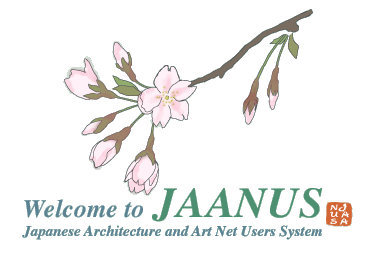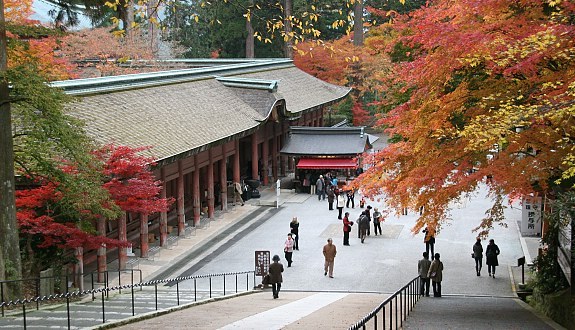OTHER PAGES ON THE LEAFLET
 In browsing last week I came across a new resource for those of us interested in Japanese Buddhism. The site is at: http://www.aisf.or.jp/~jaanus/
In browsing last week I came across a new resource for those of us interested in Japanese Buddhism. The site is at: http://www.aisf.or.jp/~jaanus/
JAANUS is the on-line Dictionary of Japanese Architectural and Art Historical Terminology compiled by Dr. Mary Neighbour Parent, an American art historian with a long and distinguished career in Asian art.
This dictionary contains approximately 8000 terms related to traditional Japanese architecture and gardens, painting, sculpture and art-historical iconography from approximately the 1st century A.D. to the end of the Edo period (1868). Terms from related fields such as lacquer, ceramics, textiles and metalwork have been included where they are considered to be of general interest and/or impact on the principal fields of architecture, painting and sculpture. These definitions are not translations from any one Japanese monolingual dictionary, but have been collated from a range of specialist sources and scholarly publications, and from direct observation and study. Many have never before been defined in English.
This is not a definitive work. Although every effort has been made to create as accurate a compilation as possible, new discoveries will, most likely, complement our endeavor. However, new discoveries can sometimes negate old findings, facts or myths. Therefore, should you find discrepancies or errors, let us know as any corrections can benefit all.
While this is not a source for Dharma terms, it reflects the overlap between Japanese Buddhism and art, with a great deal of similar terminology.
Yours in the Dharma,
Innen, doshu
om namo amida butsu
Our Tendai tradition began some 1200 years ago when our Dharma grandfather, Saicho, established his main temple in the mountains above the main cities of Nara and Kyoto, overlooking beautiful Lake Biwa. Hie-zan (Mount Hiei) has been the home for Tendai ever since and comprises dozens of small and large temples and shrines, all spread over an expansive natural landscape. The entire grounds of Hiezan Enryakuji is thousands of acres of natural mountain and forest, which was designated by the UN as a world cultural and heritage site in 1994. I can attest to the stunning beauty of The Mountain, as it is called locally. My visit in 2013 left me with powerful impressions and memories of our own Dharma home.
 If you would like some detail and images of the site and many of the buildings on Enryakuji, here is an official brochure which provides photos and description.
If you would like some detail and images of the site and many of the buildings on Enryakuji, here is an official brochure which provides photos and description.
http://www.hieizan.or.jp/_att/english.pdf
Yours in the Dharma,
Innen, doshu
om namo amida butsu
At our Thursday sitting we were discussing our favourite twins, Jizo and Kokuzo. Jizo (Earth Storehouse) represents the Six Realms of Material Being, and, as expressed in the Sutra of Earthstore Bodhisattva, his promise is to travel through all six realms until all beings are liberated. Kokuzo, The Realm of Infinite Possibilities, represents potentiality, that which is yet to be manifested. These two have been part of our learning and practice for years and in their relationship we can see the fundamental philosophical stance of Tendai - the Way of Harmony.
 Mizuko Jizo
Mizuko Jizo
 Kokuzo
Tendai as expounded by both Chi-ih and Saicho proposes that we can understand our experience through three perspectives - the conventional (the world is just as we see it, nothing more), the absolute (the world as we experience it is just illusory) and the harmonious reconciliation of these two views. Like wise, Jizo is the world as we see it and Kokuzo is the yet-to-be world, and their twin-ship illustrates how these apparent opposites can be related.
Kokuzo
Tendai as expounded by both Chi-ih and Saicho proposes that we can understand our experience through three perspectives - the conventional (the world is just as we see it, nothing more), the absolute (the world as we experience it is just illusory) and the harmonious reconciliation of these two views. Like wise, Jizo is the world as we see it and Kokuzo is the yet-to-be world, and their twin-ship illustrates how these apparent opposites can be related.
Interestingly too is the adoption of each of these by different Japanese sects. The Pure Land (Jodo) sect which emphasizes a personal and devotional relationship practice views Jizo as a manifestation of Amida. Anyone who experiences the Japanese landscape will of course encounter Jizo, with his red hats and scarves, in innumerable sites around temples and even in secular sites. Both Jizo (as the guardian of death) and Amitabha (as the Lord of the Western or Sunset Land) emphasize the sun setting in the west. On the other hand, Shingon, the predominantly esoteric tradition which holds that Buddhas are beyond any human experience except through symbolic means incorporates Kokuzo. He is associated with the East and the rising sun and morning star.
Yours in the Dharma,
Innen, doshu
om namo amida butsu


